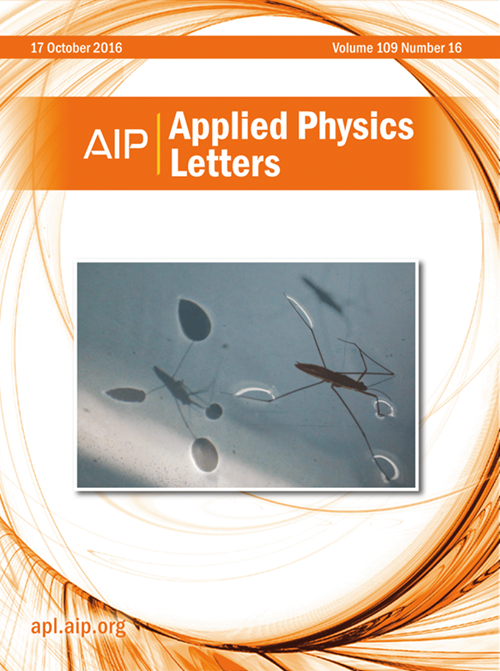表面声波驱动下悬浮袋的变形与运动
IF 3.6
2区 物理与天体物理
Q2 PHYSICS, APPLIED
引用次数: 0
摘要
Skyrmion袋具有稳定的自旋纹理拓扑结构,具有任意拓扑电荷,具有成为赛道存储器新载体的潜力。在skyrmion袋被发现后,单个skyrmion的注射和驱动方法逐渐被应用到skyrmion袋的操作中。然而,传统的方法,包括自旋电流、磁各向异性梯度、微波场产生的自旋波等,不可避免地带来了高能耗和小型化困难的问题。随着应变电子学的发展,声波已被广泛用于操纵磁拓扑结构。本文采用数值方法研究了表面声波驱动下的skyrmion袋的动力特性。结果表明,材料阻尼、声波振幅和频率对skyrmion袋性能有较大影响。随着阻尼的减小,skyrmion袋的移动速度逐渐加快。此外,振幅或频率的增加也会对skyrmion袋的速度产生类似的影响。与声波驱动的单个skyrmions不同,铁磁膜中强磁弹性耦合效应和skyrmions袋丰富的自旋织构导致skyrmions变形,速度提高38%。此外,skyrmion的变形是由表面声波引起的原位旋转和呼吸的综合效应。这项工作证明了表面声波可以驱动skyrmion袋,这为未来基于skyrmion袋的多种信息存储提供了潜在的应用。本文章由计算机程序翻译,如有差异,请以英文原文为准。
Deformation and motion of skyrmion bags driven by surface acoustic wave
Skyrmion bags are stable spin textured topologies with arbitrary topological charges, and have the potential to become new carriers in racetrack memory. After the discovery of skyrmion bags, the injection and driving methods of a single skyrmion are gradually applied to the manipulation of skyrmion bags. However, traditional methods, including spin current, magnetic anisotropic gradient, and spin waves generated by microwave fields, inevitably bring problems of high energy consumption and difficulty in miniaturization. With the development of strain electronics, acoustic waves have been widely used to manipulate magnetic topologies. Here, we numerically investigate the dynamical characteristic of skyrmion bags driven by surface acoustic waves. The results show that material damping and acoustic wave amplitude and frequency have a great influence on the skyrmion bag. With decrease in damping, the skyrmion bags move gradually faster. Also, increase in amplitude or frequency can generate similar effect on the velocity of skyrmion bags. Unlike acoustic wave-driven single skyrmions, the strong magnetoelastic coupling effect in the ferromagnetic film and the rich spin texture of skyrmion bags induce deformation in the skyrmion, along with a 38% increase in its velocity. Further, the deformation of the skyrmion is a combined effect of in situ rotation and breath caused by surface acoustic waves. This work demonstrates that the surface acoustic wave can be used to drive skyrmion bags, which offers potential applications for diverse storage of information based on the skyrmion bags in the future.
求助全文
通过发布文献求助,成功后即可免费获取论文全文。
去求助
来源期刊

Applied Physics Letters
物理-物理:应用
CiteScore
6.40
自引率
10.00%
发文量
1821
审稿时长
1.6 months
期刊介绍:
Applied Physics Letters (APL) features concise, up-to-date reports on significant new findings in applied physics. Emphasizing rapid dissemination of key data and new physical insights, APL offers prompt publication of new experimental and theoretical papers reporting applications of physics phenomena to all branches of science, engineering, and modern technology.
In addition to regular articles, the journal also publishes invited Fast Track, Perspectives, and in-depth Editorials which report on cutting-edge areas in applied physics.
APL Perspectives are forward-looking invited letters which highlight recent developments or discoveries. Emphasis is placed on very recent developments, potentially disruptive technologies, open questions and possible solutions. They also include a mini-roadmap detailing where the community should direct efforts in order for the phenomena to be viable for application and the challenges associated with meeting that performance threshold. Perspectives are characterized by personal viewpoints and opinions of recognized experts in the field.
Fast Track articles are invited original research articles that report results that are particularly novel and important or provide a significant advancement in an emerging field. Because of the urgency and scientific importance of the work, the peer review process is accelerated. If, during the review process, it becomes apparent that the paper does not meet the Fast Track criterion, it is returned to a normal track.
 求助内容:
求助内容: 应助结果提醒方式:
应助结果提醒方式:


